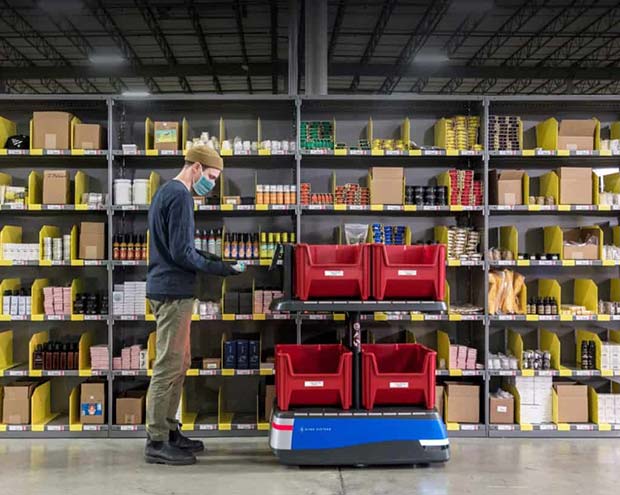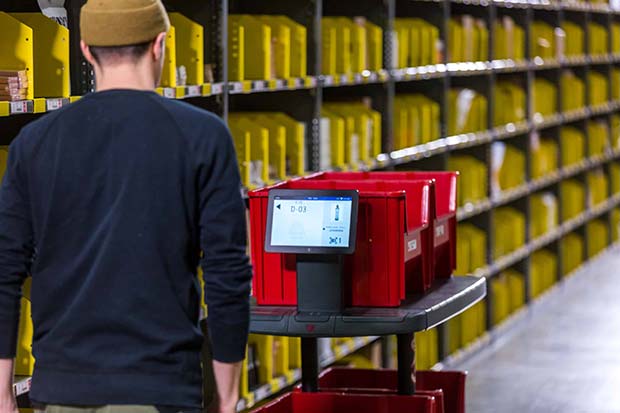COVID-19 changed the supply chain overnight. Buying behaviours that were predicted to become the norm by 2026 were suddenly a reality. Based on the US Census Bureau, there was more eCommerce growth in the first six months of COVID than the previous five years combined.
 Supply chain leaders know that fulfilment is the key to differentiation, and in some cases, survival. Bain & Company reports that 40% of retail leaders expect to increase their total supply chain investment to keep pace. With this new reality, more flexible fulfilment automation —especially automation that leverages collaborative mobile robots (CMRs) — is top of mind for businesses that want to drive growth and create new efficiencies amid unpredictable demand and an uncertain labour market.
Supply chain leaders know that fulfilment is the key to differentiation, and in some cases, survival. Bain & Company reports that 40% of retail leaders expect to increase their total supply chain investment to keep pace. With this new reality, more flexible fulfilment automation —especially automation that leverages collaborative mobile robots (CMRs) — is top of mind for businesses that want to drive growth and create new efficiencies amid unpredictable demand and an uncertain labour market.
Here are three ways these alternatives to traditional automation create new opportunities for fulfilment operations to meet the challenges of today.
1. Implement quickly without disrupting your operations
Although peak 2020 is barely in the rearview mirror, planning for peak 2021 is already a priority for operations seeking to improve performance. Most companies can’t afford to completely abandon their current system or infrastructure; it’s too disruptive and too expensive. And traditional warehouse automation systems can take 12 to 24 months to go live. So, how to best prepare for 2021? Collaborative mobile robots provide a faster alternative for implementing automation and are safer, customizable and designed to work with your existing warehouse processes and staff. Some robotics systems, such as 6 River Systems’ wall-to-wall fulfilment solution, can be implemented in as little as four weeks and support faster, more accurate operational execution across putaway, picking, sorting and packing.
The result is a facility-wide (or even enterprise-wide) network that can support growth, without disrupting your existing fulfilment operations. Once that network is in place, you can…
2. Train more associates more easily, for less
Even before COVID-19, warehouse labor was a challenge. Now, the massive increase in online purchases has created a significant crunch on capacity, both in terms of fulfilment and transportation, and the demand for qualified workers continues to rise. Retailers and small-to-midsize 3PLs have been placed under tremendous pressure to maintain SLAs in the face of insufficient labour resources. All of this is a strong recipe towards automation.
With training built into the design, onboarding is simpler with collaborative mobile robots. It can take mere minutes to learn, and as little as a few hours to reach full productivity. Plus, fewer mechanical touchpoints and integrations make them more intuitive to use — some collaborative robots even guide your associates through the picking process. Designed to leverage AI and machine learning, these systems to make data-driven decisions in real-time. By guiding associates from task to task and optimizing picking routes, CMRs empower associates to handle several tasks within one trip on the floor, thereby accomplishing more in less time. It also reduces steps between tasks and streamlines pick paths, reducing unnecessary walking.
These innovations accelerate onboarding, equipment training and, ultimately, time to productivity, even for the greenest of hires. Another substantial benefit? Faster training times translate directly into the bottom line, and also allows your business to be more nimble and adjust quickly to the rapidly changing world. Which leads us to…
 3. Create the flexibility and scalability you need to meet unpredictable demand
3. Create the flexibility and scalability you need to meet unpredictable demand
The need to adjust your warehouse’s capabilities to accommodate fluctuating demand is a common challenge in today’s fulfilment landscape — and inflexible systems or legacy automation simply don’t meet the growing need to adapt. Similarly, the use of traditional tactics like changing warehouse layouts and the use of alternate shifts may provide flexibility in certain situations, but they can be difficult and costly to coordinate. CMRs, however, can easily be retrofitted into any existing warehouse layout or design without the need for major changes to racking, bolts, or shuttles.
It is also easy to add additional robots and temporary labour to adjust for this demand, far more quickly than otherwise possible. And CMRs can be rented, transferred among facilities and/or brought online quickly to adapt to changing needs, providing necessary scalability in the modern warehousing world. Temporary and portable capacity, when and where you need it, is something that no traditional automation can offer.
6 River Systems
w: 6river.com




Comments are closed.